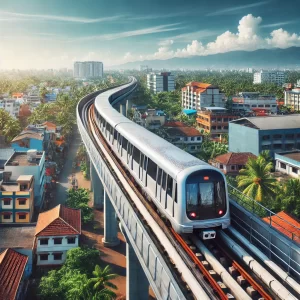“Kochi Metro’s Expansion: A Game Changer for Urban Transport”

Kochi, the Queen of the Arabian Sea, has always been a city on the move — from its bustling spice markets to the serene backwaters and the thriving tech hubs. However, with rapid urbanization and a growing population, the city’s transportation network has faced mounting pressure. Enter the Kochi Metro, a transformative project that has reshaped urban mobility in the city. With its ambitious expansion plans in 2025, the metro system is set to become a true game changer for urban transport in Kochi. Let’s delve into the details of this revolutionary development.
1. The Journey So Far: Kochi Metro’s Rise
Kochi Metro’s story began with the first phase inaugurated in June 2017, covering a 13.4 km stretch from Aluva to Palarivattom. By 2019, the network extended to Maharaja’s College and Thykoodam, eventually reaching Petta. The project not only brought modern infrastructure but also became a symbol of sustainable urban development, integrating art, culture, and inclusivity — from murals depicting Kerala’s heritage to jobs for transgender individuals within the metro workforce.
With its growing popularity and impressive ridership numbers, the metro’s success demanded further expansion to cover more areas and improve connectivity.
2. The Expansion Blueprint
In 2025, Kochi Metro is undergoing an extensive expansion that promises to change the face of the city’s transport system. The new phases include:
- Phase 2: Extending from JLN Stadium to Infopark (11.2 km)
- Phase 3: A critical stretch from Aluva to Angamaly to connect the metro with Cochin International Airport.
- Water Metro Integration: Seamless connectivity between the metro system and the recently launched Kochi Water Metro, offering an intermodal transportation experience.
These expansions aim to ease traffic congestion, reduce carbon emissions, and ensure faster, more efficient transit across the city.
3. Key Infrastructure Upgrades
The latest expansion comes with several infrastructure upgrades designed to improve passenger experience and operational efficiency:
- Automated signaling systems: Enhancing safety and reducing wait times between trains.
- Driverless metro trains: Bringing the city closer to advanced urban transport systems globally.
- Elevated stations with modern facilities: More parking spaces, retail areas, and integrated bus bays.
- Renewable energy integration: Solar panels installed on station roofs to power metro operations.
These upgrades are expected to make commuting more comfortable, sustainable, and time-efficient for residents and tourists alike.
4. Socio-Economic Impact
Kochi Metro’s expansion isn’t just about better connectivity — it’s a catalyst for socio-economic development across the city. Here’s how:
- Boosting Real Estate: Areas along the new metro routes are witnessing a surge in property demand and value, spurring commercial and residential developments.
- Job Creation: From construction to metro operations, the expansion project has generated thousands of jobs for locals, contributing to the city’s economy.
- Promoting Tourism: With improved access to hotspots like Fort Kochi, Mattancherry, and Lulu Mall, tourists can explore Kochi conveniently.
- Reducing Road Traffic: The metro encourages residents to shift from private vehicles to public transport, easing congestion and lowering pollution levels.
5. Environmental Sustainability
Kochi Metro’s expansion stands out for its commitment to sustainability. Some key eco-friendly initiatives include:
- Solar-powered stations: A significant portion of metro operations relies on renewable energy, reducing dependency on conventional power sources.
- Rainwater harvesting systems at stations to promote water conservation.
- Energy-efficient trains equipped with regenerative braking systems that help reduce electricity consumption.
- Promoting non-motorized transport (NMT): With dedicated cycling tracks and pedestrian-friendly pathways near metro stations, Kochi encourages greener last-mile connectivity.
These measures make the metro a critical player in shaping a greener, more sustainable urban future for Kochi.
6. Challenges and Road Ahead
While the expansion is promising, it doesn’t come without challenges:
- Funding and Cost Management: The overall cost of Phase 2 alone is estimated at over ₹2,000 crore. Balancing investments without burdening taxpayers remains crucial.
- Land Acquisition Delays: Expanding into dense urban areas often leads to disputes over land acquisition, slowing progress.
- Integration with Other Transport Modes: Ensuring seamless integration with buses, ferries, and the water metro network is essential for a unified public transport ecosystem.
Despite these challenges, the authorities are pushing ahead with strategic planning, international funding support, and public-private partnerships to meet project deadlines.
7. The Vision: Kochi Metro in 2030
Looking beyond 2025, Kochi Metro’s long-term vision paints an inspiring picture. By 2030, the metro aims to:
- Cover over 100 km of track length, reaching suburbs and satellite towns.
- Achieve full electrification through solar and alternative renewable energy sources.
- Incorporate smart ticketing solutions using biometric and AI-based systems for a contactless, cashless travel experience.
- Promote Transit-Oriented Development (TOD), encouraging businesses, offices, and entertainment hubs near metro corridors.
If the current momentum continues, Kochi could well become a model city for urban transport, setting an example for other Indian metros.
Final Thoughts
Kochi Metro’s expansion isn’t just about faster travel — it’s about transforming urban life. By improving connectivity, reducing environmental impact, boosting the economy, and enhancing the overall quality of life, this metro network is poised to be a game changer in the city’s development story.
For the residents of Kochi, the metro expansion represents more than infrastructure — it symbolizes progress, resilience, and a commitment to a better, more connected future. As the metro network grows, Kochi is undoubtedly on track to becoming a smarter, greener, and more accessible city for all.
Are you ready to hop on board this exciting journey?
0 Comments